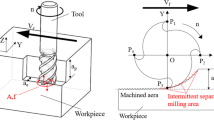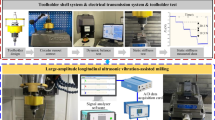Abstract
This paper presents the results of an experimental investigation into the effects of cutting speed on cutting force and surface integrity during which experiments for conventional milling and longitudinal-torsional ultrasonic vibration-assisted milling for machining of a TC18 alloy were performed. Through an analysis of tool-workpiece kinematic characteristics, several advantages of torsional vibration cutting in the non-separated cutting area are illustrated, including variable cutting thickness, variable-front-angle cutting, and chip pulling by the cutter. The cutting force, surface quality, residual stress, and microstructure of the cutting surface were studied in detail during conventional milling and longitudinal-torsional ultrasonic vibration-assisted milling processes at different rotational speeds. The experimental results show that the average radial cutting force and the surface residual compressive stress both decreased with an increase in cutting speed. During the process of torsional vibration milling, the surface roughness increased with an increase in cutting speed before the rotational speed reached the critical speed (1107 rpm) of torsional vibration cutting without separation. After the critical speed was reached, the surface roughness decreased with an increase in cutting speed. Compared with conventional milling, the cutting force and surface roughness of longitudinal-torsional ultrasonic vibration-assisted milling are reduced by 16.05% and 45.65%, respectively. Then, the surface residual compressive stress can be increased by 24.35%. In addition, for both milling processes, the deformation layer thickness increased with an increase in rotational speed, and when the cutting speed is 1400 rpm, the depth of plastic deformation of the vibration milling sample can reach about 7.5 μm. When the rotational speed was greater than 1100 rpm, the grain was significantly elongated and refined along the cutting direction.









Similar content being viewed by others
References
Shao H, Shan D, Wang K, Zhang G, Zhao Y (2019) Massive α precipitation selectivity and tensile fracture behavior of TC18 alloy. J Alloy Compd 797:10–17. https://doi.org/10.1016/j.jallcom.2019.04.315
Qu FS, Zhou YH, Zhang LY, Wang ZH, Zhou J (2015) Research on hot deformation behavior of Ti-5Al-5Mo-5V-1Cr-1Fe alloy. Mater Design 69:153–162. https://doi.org/10.1016/j.matdes.2014.12.021
Zhang CM, Mu AL, Wang Y, Zhang H (2020) Study on dynamic mechanical properties and constitutive model construction of TC18 titanium alloy. Metals-Basel 10(1):44. https://doi.org/10.3390/met10010044
Ning YQ, Xie BC, Liang HQ, Li H, Yang XM, Guo HZ (2015) Dynamic softening behavior of TC18 titanium alloy during hot deformation. Mater Des 71:68–77. https://doi.org/10.1016/j.matdes.2015.01.009
Ning YQ, Luo X, Liang HQ, Guo HZ, Zhang JL, Tan K (2015) Competition between dynamic recovery and recrystallization during hot deformation for TC18 titanium alloy. Mater Sci Eng A 635:77–85. https://doi.org/10.1016/j.msea.2015.03.071
Ran C, Chen PW, Li L, Zhang WF (2017) Dynamic shear deformation and failure of Ti-5Al-5Mo-5V-1Cr-1Fe titanium alloy. Mater Sci Eng A 694:41–47. https://doi.org/10.1016/j.msea.2017.03.114
Sun SY, Lv WJ (2016) Microstructure and mechanical properties of TC18 Titanium alloy. Rare Metal Mat Eng 45(5):1138–1141. https://doi.org/10.1016/S1875-5372(16)30108-4
Ahmed M, Savvakin DG, Ivasishin OM, Pereloma EV (2014) The effect of ageing on microstructure and mechanical properties of powder Ti-5Al-5Mo-5V-1Cr-1Fe alloy. Mater Sci Eng A 605:89–97. https://doi.org/10.1016/j.msea.2014.03.030
Ma JY, Luo DC, Liao XP, Zhang ZK, Huang Y, Lu J (2021) Tool wear mechanism and prediction in milling TC18 titanium alloy using deep learning. Measurement 173:108554. https://doi.org/10.1016/j.measurement.2020.108554
Ni CB, Zhu LD, Ning JS, Yang ZC, Liu CF (2019) Research on the characteristics of cutting force signal and chip in ultrasonic vibration-assisted milling of titanium alloys. J Mech Eng 55(07):207–216. https://doi.org/10.3901/JME.2019.07.207
He GH, Wu MY, Li LX, Zou LL, Cheng C (2018) Study on The Formation Mechanism Of Phase Transformation And The Influencing Factors Of Cutting Layer Of The Typical Titanium Alloy. J Mech Eng 54(17):133–141. https://doi.org/10.3901/JME.2018.17.133
Kang RK, Ma FJ, Dong ZG, Guo DM (2012) Ultrasonic assisted machining of difficult-to-cut material. Aeronautical manufacturing technology (16):44–49. https://doi.org/10.16080/j.issn1671-833x.2012.16.022
Zhu LD, Ni CB, Yang ZC, Liu CF (2019) Investigations of micro-textured surface generation mechanism and tribological properties in ultrasonic vibration-assisted milling of Ti-6Al-4V. Precis Eng 57:229–243. https://doi.org/10.1016/j.precisioneng.2019.04.010
Niu Y, Jiao F, Zhao B, Tong JL (2019) Experiment of machining induced residual stress in longitudinal torsional ultrasonic assisted milling of Ti-6Al-4V. Surface Technology 48(10):41–51. https://doi.org/10.16490/j.cnki.issn.1001-3660.2019.10.005
Ni CB, Zhu LD, Liu CF, Yang ZC (2018) Analytical modeling of tool-workpiece contact rate and experimental study in ultrasonic vibration-assisted milling of Ti-6Al-4V. Int J Mech Sci 142–143:97–111. https://doi.org/10.1016/j.ijmecsci.2018.04.037
Zhang ML, Zhang DY, Geng DX, Shao ZY, Liu YH, Jiang XG (2020) Effects of tool vibration on surface integrity in rotary ultrasonic elliptical end milling of Ti-6Al-4V. J Alloy Compd 821:153266. https://doi.org/10.1016/j.jallcom.2019.153266
Wang YX, Zhang CM (2019) Cutting force and surface roughness of turning on TC18 titanium alloy. Materials for Mechanical Engineering 43(7):69–73. https://doi.org/10.11973/jxgccl201907015
Liang HQ, Guo HZ, Ning YQ, Peng XN, Qin C, Shi ZF, Nan Y (2014) Dynamic recrystallization behavior of Ti-5Al-5Mo-5V-1Cr-1Fe alloy. Mater Des 63:798–804. https://doi.org/10.1016/j.matdes.2014.06.064
Hu Z, Yi DQ, Liu HQ, Zhou XY, Zhou HW (2019) New type of macrozone in a near-β titanium alloy Ti-5Al-5Mo-5V-1Cr-1Fe. Mater Lett 238:6–9. https://doi.org/10.1016/j.matlet.2018.11.135
Ali MH, Khidhir BA, Ansari MNM, Mohamed B (2013) FEM to predict the effect of feed rate on surface roughness with cutting force during face milling of titanium alloy. HBRC Journal 9(3):263–269. https://doi.org/10.1016/j.hbrcj.2013.05.003
Zhao B, Li PT, Zhang CY, Wang XB (2020) Effect of ultrasonic vibration direction on milling characteristics of TC4 titanium alloy. Acta Aeronautica ET Astronautica Sinica 41(2):623301. https://doi.org/10.7527/S10006-893.2019.23301
Chen XX, Wang H, Zhang WW (2020) Dynamic characteristics of abrasive grains and machined surface features for variable axis diamond grinding of quartz glass. J Braz Soc Mech Sci 42(8):421. https://doi.org/10.1007/s40430-020-02473-5
Monaca A, Murray JW, Liao ZR, Speidel A, Robles-Linares JA, Axinte DA, Hardy MC, Clare AT (2021) Surface integrity in metal machining-Part II: functional performance. Int J Mach Tools Manuf 164:103718. https://doi.org/10.1016/j.ijmachtools.2021.103718
Ma C, Zhang JH, Tao GC (2017) Wear and friction properties of titanium alloy surface subject to ultrasonic vibration assisted milling. Surface Technology 46(08):115–119. https://doi.org/10.16490/j.cnki.issn.1001-3660.2017.08.019
Geng DX, Liu YH, Shao ZY, Zhang ML, Jiang XG, Zhang DY (2020) Delamination formation and suppression during rotary ultrasonic elliptical machining of CFRP. Compos B Eng 183:107698. https://doi.org/10.1016/j.compositesb.2019.107698
Shao Z, Jiang X, Geng D, Liu Y, Zhou Z, Li S, Zhang D, Zheng W (2021) The interface temperature and its influence on surface integrity in ultrasonic-assisted drilling of CFRP/Ti stacks. Compos Struct 266:113803. https://doi.org/10.1016/j.compstruct.2021.113803
Zhang ML, Zhang DY, Geng DX, Liu JJ, Shao ZY, Jiang XG (2020) Surface and sub-surface analysis of rotary ultrasonic elliptical end milling of Ti-6Al-4V. Mater Des 191:108658. https://doi.org/10.1016/j.matdes.2020.108658
Li W, Yin J, Lv LP, Xu MG, Zhang DY (2013) Study on the unseparated ultrasonic elliptical vibration cutting force. Acta Aeronautica ET Astronautica Sinica 34(09):2241–2248. https://doi.org/10.7527/S1000-6893.2013.0294
Verma GC, Pandey PM (2019) Machining forces in ultrasonic-vibration assisted end milling. Ultrasonics 94:350–363. https://doi.org/10.1016/j.ultras.2018.07.004
Zhang XF, Zheng K, Liao WH, Yao JD, Ma WR (2017) Investigation on surface integrity for ultrasonic vibration assisted milling titanium alloy. Tool Engineering 51(09):12–16. https://doi.org/10.16567/j.cnki.1000-7008.2017.09.003
Suárez A, Veiga F, Lacalle LNL, Polvorosa R, Lutze S, Wretland A (2016) Effects of ultrasonics-assisted face milling on surface integrity and fatigue life of Ni-alloy 718. J Mater Eng Perform 25(11):5076–5086. https://doi.org/10.1007/s11665-016-2343-6
Zhao B, Li PT, Zhao CY, Wang XB (2020) Fractal characterization of surface microtexture of Ti6Al4V subjected to ultrasonic vibration assisted milling. Ultrasonics 102:106052. https://doi.org/10.1016/j.ultras.2019.106052
Li X, Zhang DY (2010) Experimental study on the unseparated ultrasonic elliptical vibration cutting. J Mech Eng 46(19):177–182. https://doi.org/10.3901/JME.2010.19.177
Verma GC, Pandey PM, Dixit US (2018) Modeling of static machining force in axial ultrasonic-vibration assisted milling considering acoustic softening. Int J Mech Sci 136:1–16. https://doi.org/10.1016/j.ijmecsci.2017.11.048
Liu JJ, Jiang XG, Gao Z, Zhang ML, Zhang DY (2019) Investigation of the effect of vibration amplitude on the surface integrity in high-speed rotary ultrasonic elliptical machining for side milling of Ti-6Al-4V. J Mech Eng 55(11):215–223. https://doi.org/10.3901/JME.2019.11.215
Wang JJ, Feng PF, Zhang JF, Guo P (2018) Reducing cutting force in rotary ultrasonic drilling of ceramic matrix composites with longitudinal-torsional coupled vibration. Manuf Lett 18:1–5. https://doi.org/10.1016/j.mfglet.2018.08.002
Sun YJ, Gong H, Wang Y, Ni H (2021) Tribological viewpoint of the cutting force in rotary ultrasonic vibration-assisted side milling (RUVSM). Int J Adv Manuf Technol 114(9–10):2839–2848. https://doi.org/10.1007/s00170-021-06966-y
Niu Y, Jiao F, Zhao B, Wang XB (2019) 3D finite element simulation and experimentation of residual stress in longitudinal torsional ultrasonic assisted milling. J Mech Eng 55(13):224–232. https://doi.org/10.3901/JME.2019.13.224
Li Z, Yuan SM, Ma J, Shen J, Batako ADL (2021) Study on the surface formation mechanism in scratching test with different ultrasonic vibration forms. J Mater Process Tech 294:117108. https://doi.org/10.1016/j.jmatprotec.2021.117108
Pang Y, Feng PF, Wang JJ, Zha HT, Xu J (2021) Performance analysis of the longitudinal-torsional ultrasonic milling of Ti-6Al-4V. Int J Adv Manuf Technol 113(5–6):1255–1266. https://doi.org/10.1007/s00170-021-06682-7
Niu Y, Jiao F, Zhao B, Gao GF, Niu JJ (2020) Theoretical investigation of machining-induced residual stresses in longitudinal torsional ultrasonic–assisted milling. Int J Adv Manuf Technol 108(11–12):3689–3705. https://doi.org/10.1007/s00170-020-05495-4
Brehl DE, Dow TA (2008) Review of vibration-assisted machining. Precis Eng 32(3):153–172. https://doi.org/10.1016/j.precisioneng.2007.08.003
Funding
This work was supported by the Research Fund for High-Level Talents of Pingdingshan University (grant numbers PXY-BSQD-202014), the National Project Cultivation Fund of Pingdingshan University (grant numbers PXY-PYJJ-202105), the Key Research Project of Institutions of Higher Education in Henan Province (grant numbers 21A430029), and Henan Province Science and Technology Equipment Key Project (grant numbers 212102210349).
Author information
Authors and Affiliations
Contributions
Supervision was conducted by Jian Wang and Bo Zhao. Conceptualization was performed by Weibo Xie and Erbo Liu. Visualization was conducted by Weibo Xie. Writing of the original draft was done by Weibo Xie. Data curation was performed by Weibo Xie and Yongbo Chai. Review and editing were conducted by Xikui Wang and Liquan Yang. Funding was acquired by Xikui Wang, Guangxi Li, and Jian Wang.
Corresponding authors
Ethics declarations
Ethics approval
The authors state that the present work is in compliance with the ethical standards.
Conflict of interest
The authors declare no competing interests.
Additional information
Publisher's Note
Springer Nature remains neutral with regard to jurisdictional claims in published maps and institutional affiliations.
Supplementary information
Below is the link to the electronic supplementary material.
Rights and permissions
About this article
Cite this article
Xie, W., Zhao, B., Liu, E. et al. Surface integrity investigation into longitudinal-torsional ultrasonic vibration side milling for a TC18 titanium alloy—part I: the effects of cutting speed on cutting force and surface integrity. Int J Adv Manuf Technol 120, 2701–2713 (2022). https://doi.org/10.1007/s00170-022-08874-1
Received:
Accepted:
Published:
Issue Date:
DOI: https://doi.org/10.1007/s00170-022-08874-1




